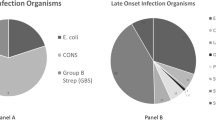Abstract
Objective:
Infants with gastroschisis have significant perinatal morbidity including long hospitalizations and feeding intolerance. Two thirds are premature and 20% are growth restricted. Despite these known risk factors for post-natal complications, little is known about readmission for infants with gastroschisis. Our objective was to determine the frequency and indication for hospital readmission after initial discharge among infants with gastroschisis.
Study Design:
Retrospective cohort study. All surviving infants treated for gastroschisis at Cincinnati Children's Hospital Medical Center, born between January 2006 and December 2008 were included. Main outcome measures included the frequency and indication for readmission. Associated neonatal risk factors also were assessed.
Result:
Fifty-eight patients were analyzed. Twenty-three (40%) subjects were readmitted (five with multiple readmissions); 65% of readmissions occurred in the first year and 70% involved complications directly related to gastroschisis. The most common reasons for readmission were bowel obstruction and abdominal distention/pain. Median time to readmission directly related to gastroschisis was 23 weeks (range 5 to 92). All three infants with home parenteral nutrition were readmitted. Readmission was not associated with gestational age, birth weight or length of initial hospitalization.
Conclusion:
Readmission after initial hospitalization is common in gastroschisis patients. Parental counseling should include education regarding the possibility of complications requiring readmission. Determinants of readmission require further study.
This is a preview of subscription content, access via your institution
Access options
Subscribe to this journal
Receive 12 print issues and online access
$259.00 per year
only $21.58 per issue
Buy this article
- Purchase on Springer Link
- Instant access to full article PDF
Prices may be subject to local taxes which are calculated during checkout

Similar content being viewed by others
References
Laughon M, Meyer R, Bose C, Wall A, Otero E, Heerens A et al. Rising birth prevalence of gastroschisis. J Perinatol 2003; 23: 291–293.
Puligandla PS, Janvier A, Flageole H, Bouchard S, Mok E, Laberge JM . The significance of intrauterine growth restriction is different from prematurity for the outcome of infants with gastroschisis. J Pediatr Surg 2004; 39: 1200–1204.
Blakelock RT, Harding JE, Kolbe A, Pease PW . Gastroschisis: can the morbidity be avoided? Pediatr Surg Int 1997; 12: 276–282.
Arnold MA, Chang DC, Nabaweesi R, Colombani PM, Bathurst MA, Mon KS et al. Risk stratification of 4344 patients with gastroschisis into simple and complex categories. J Pediatr Surg 2007; 42: 1520–1525.
South AP, Marshall DD, Bose CL, Laughon MM . Growth and neurodevelopment at 16 to 24 months of age for infants born with gastroschisis. J Perinatol 2008; 28: 702–706.
Kandasamy Y, Whitehall J, Gill A, Stalewski H . Surgical management of gastroschisis in North Queensland from 1988 to 2007. J Paediatr Child Health 2010; 46: 40–44.
Piper HG, Jaksic T . The impact of prenatal bowel dilation on clinical outcomes in neonates with gastroschisis. J Pediatr Surg 2006; 41: 897–900.
van Eijck FC, Wijnen RM, van Goor H . The incidence and morbidity of adhesions after treatment of neonates with gastroschisis and omphalocele: a 30-year review. J Pediatr Surg 2008; 43: 479–483.
Koivusalo A, Lindahl H, Rintala RJ . Morbidity and quality of life in adult patients with a congenital abdominal wall defect: a questionnaire survey. J Pediatr Surg 2002; 37: 1594–1601.
Henrich K, Huemmer HP, Reingruber B, Weber PG . Gastroschisis and omphalocele: treatments and long-term outcomes. Pediatr Surg Int 2008; 24: 167–173.
Davies BW, Stringer MD . The survivors of gastroschisis. Arch Dis Child 1997; 77: 158–160.
Weinsheimer RL, Yanchar NL, Bouchard SB, Kim PK, Laberge JM, Skarsgard ED et al. Gastroschisis closure—does method really matter? J Pediatr Surg 2008; 43: 874–878.
Owen A, Marven S, Jackson L, Antao B, Roberts J, Walker J et al. Experience of bedside preformed silo staged reduction and closure for gastroschisis. J Pediatr Surg 2006; 41: 1830–1835.
Singh SJ, Fraser A, Leditschke JF, Spence K, Kimble R, Dalby-Payne J et al. Gastroschisis: determinants of neonatal outcome. Pediatr Surg Int 2003; 19: 260–265.
Pastor AC, Phillips JD, Fenton SJ, Meyers RL, Lamm AW, Raval MV et al. Routine use of a SILASTIC spring-loaded silo for infants with gastroschisis: a multicenter randomized controlled trial. J Pediatr Surg 2008; 43: 1807–1812.
Acknowledgements
We thank the Perinatal Institute and Intestinal Rehabilitation Program at Cincinnati Children's Hospital Medical Center for financially supporting this research effort.
Author information
Authors and Affiliations
Corresponding author
Ethics declarations
Competing interests
The authors declare no conflict of interest.
Rights and permissions
About this article
Cite this article
South, A., Wessel, J., Sberna, A. et al. Hospital readmission among infants with gastroschisis. J Perinatol 31, 546–550 (2011). https://doi.org/10.1038/jp.2010.206
Received:
Revised:
Accepted:
Published:
Issue Date:
DOI: https://doi.org/10.1038/jp.2010.206


